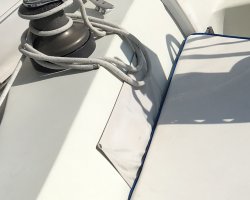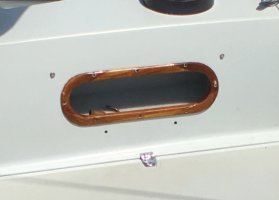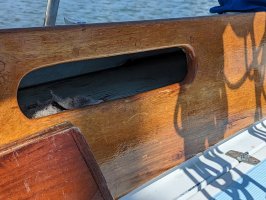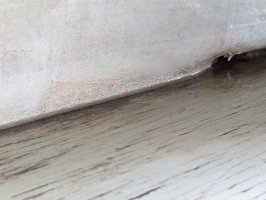You are using an out of date browser. It may not display this or other websites correctly.
You should upgrade or use an alternative browser.
You should upgrade or use an alternative browser.
paul culver
Member III
On my E29 they don't drain. I sponge them out when needed.
David Grimm
E38-200
On the 38-200 it's a little different. The combing box goes deeper than the opening. Below the opening there are 2 holes in the fiberglass for drainage into the cockpit. The old plastic box is cracked and has holes. I assume rain water passes through and into the bildge at this point. Eventually I will make a new box out of fiberglass.
I don't know how the 35-2 drains, or how the bin is constructed. But it would be easy to make a cover for it.

The E381, and other '80s boats, have plastic bin inserts. They have often been destroyed by UV by the time a contemporary owner takes possession. I fiberglassed the broken bin from below, which preserved its shape and utility. If the base is unsightly, just cut a plastic kitchen placemat of the correct color to fit the bottom.

Mine drains through obvious holes, as seen here. It is sunlight that tends to destroy the teak surround and the plastic bin base. A Sunbrella cover keeps water out and is easy to remove when sailing, although I seldom bother, as the cover flips easily and it hides the sail ties and potato chips inside.

The E381, and other '80s boats, have plastic bin inserts. They have often been destroyed by UV by the time a contemporary owner takes possession. I fiberglassed the broken bin from below, which preserved its shape and utility. If the base is unsightly, just cut a plastic kitchen placemat of the correct color to fit the bottom.

Mine drains through obvious holes, as seen here. It is sunlight that tends to destroy the teak surround and the plastic bin base. A Sunbrella cover keeps water out and is easy to remove when sailing, although I seldom bother, as the cover flips easily and it hides the sail ties and potato chips inside.
Last edited:
tenders
Innocent Bystander
The other problem, besides rain that doesn't drain, is that birds like to make nests in those boxes!
I made covers out of 1/2" StarBoard, with a lip on the top so they rest on the edge of the coaming, and with two eyes attached to the lip anchoring bungee cord that wraps around the nearby cleats so the covers are held in place. The bungee cord lasts about two seasons.* The StarBoard has lasted...gee...22 years so far?
And years ago I dug out the old warped plywood layers and faired over what was left with white-tinted epoxy.
*The bungee cord system replaced wooden cleats I'd put inside the covers. One cleat was fixed in place; the other was attached to a toilet-paper-roll-holder anchored to the cover, which worked as a spring-loaded piston to squeeze the cover against the hole. This setup was greatly amusing, and worked pretty well, except that for some reason they don't make salt-water-resistant toilet-paper-roll-holders, and they only lasted a few weeks before the springs rusted.
I made covers out of 1/2" StarBoard, with a lip on the top so they rest on the edge of the coaming, and with two eyes attached to the lip anchoring bungee cord that wraps around the nearby cleats so the covers are held in place. The bungee cord lasts about two seasons.* The StarBoard has lasted...gee...22 years so far?
And years ago I dug out the old warped plywood layers and faired over what was left with white-tinted epoxy.
*The bungee cord system replaced wooden cleats I'd put inside the covers. One cleat was fixed in place; the other was attached to a toilet-paper-roll-holder anchored to the cover, which worked as a spring-loaded piston to squeeze the cover against the hole. This setup was greatly amusing, and worked pretty well, except that for some reason they don't make salt-water-resistant toilet-paper-roll-holders, and they only lasted a few weeks before the springs rusted.
tenders
Innocent Bystander
On the older boats the holes wouldn’t drain standing water. The coaming boxes are sloped outboard - so they only drain when heeled to the opposite side.
I realized this problem really needed to be solved when the cold water poured all over my passengers after a few weeks of disuse…and the water was green with algae. Left a poor impression.
I realized this problem really needed to be solved when the cold water poured all over my passengers after a few weeks of disuse…and the water was green with algae. Left a poor impression.
Really. That's weird. Covers, then. Or make a replacement coaming box, if it's worth the trouble. But I will quit trying to solve a problem I don't understand.
gareth harris
Sustaining Member
There is no way of draining them without getting creative with hoses since beneath the port side is the quarter berth and beneath the other side is the cockpit storage. I got good covers made to protect the teak varnish from the sun, and they had an added benefit of preventing water getting in there, except when under sail when a sponge was the only way to remove it.
Gareth
Freyja E35 No. 241 1972
Gareth
Freyja E35 No. 241 1972



